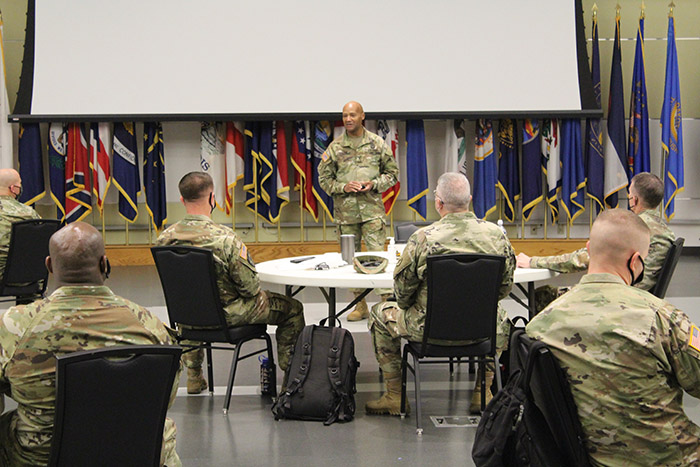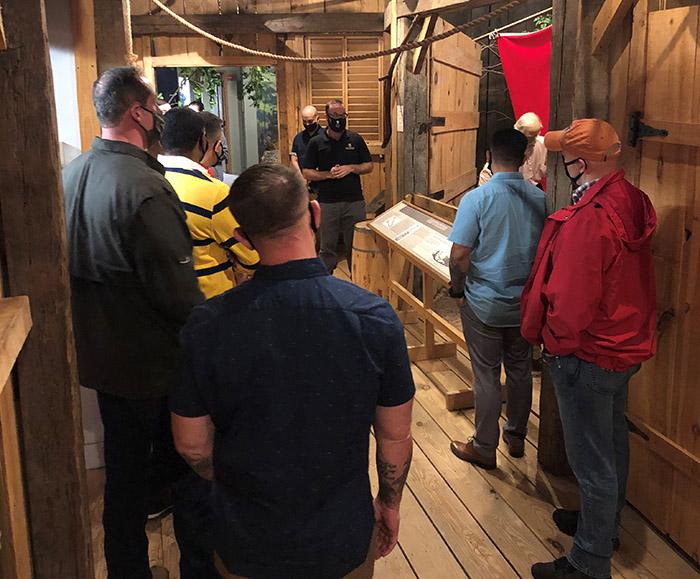Senior Leaders Talk Resiliency, Achievement at Week-Long Event

The U.S. Army Medical Research and Development Command gathered nearly two dozen Soldiers from across USAMRDC's direct reporting units for a Senior Enlisted Leader off-site event from May 3 to May 7. The purpose of the event was to facilitate communication and spur collaboration between USAMRDC subordinate units while further discussing key challenges currently facing the Army; including the ongoing novel coronavirus pandemic, burgeoning global tensions and continuing efforts to modernize the Army for potential future conflicts.
"We're at a crucible right now," said Brig. Gen. Michael J. Talley, commanding general of USAMRDC and Fort Detrick, Maryland, referencing the aforementioned crop of challenges during his address to the group on May 4. "It's important that we're all synchronized as we move forward so that you can communicate the message."
That message – the need to build a leaner, quicker Army focused on key strategies such as dominating battlefield information spaces and expanding medical care possibilities (and more specifically, enduring efforts to turn the "Golden Hour" into the "Golden Day" and beyond) – was driven home by a slew of both individual and team-oriented activities scheduled over the course of the week.

On May 3, the group visited both the National Museum of Civil War Medicine in Frederick, Maryland, and the Gettysburg National Military Park in Gettysburg, Pennsylvania, to gain perspective on the lengthy history of American battlefield medicine and associated technological advancements over the course of the last 150 years. Notable among the topics of discussion across both sites were the contributions of Major Johnathan Letterman, a 19th century physician whose reorganization of the Union Army's medical forces during the Civil War – including the first-ever deployment of dedicated ambulance services – continues to influence modern military and civilian medical treatment to this day.
On May 4, the group assembled at the Fort Detrick Auditorium for a daylong series of group activities designed to both orient enlisted Soldiers to USAMRDC's family of laboratories and, further, to brainstorm how to improve and expand the Command's impact and reach within the larger U.S. Department of Defense in the short and long term.
"This has been a great experience building relationships through networking," said Walter Reed Army Institute of Research Command Sergeant Major Rodmond Churchill, "and beyond that, it's given us an opportunity to leverage resources outside of our organization to accomplish our common goals."
For USAMRDC Command Sergeant Major Victor Laragione – who organized the event chiefly to synchronize Command-wide research efforts and boost awareness among DRUs – the event also served as an environment for both established and future leaders to discuss effective methods and techniques for accomplishing personal and professional goals.
"It's important to interact with each other, to talk with each other, and to make those connections," said Laragione. "It's important to take these conversations back to their laboratories and share the message."

On May 5, the group received a guided tour of USAMRDC's Telemedicine and Advanced Technology Research Center, which included a demonstration in TATRC's fabrication laboratory. The event culminated with a two-day leadership training seminar – specifically using techniques from the Arbinger Institute – from May 6-7.
"This is really for the enlisted Soldier to help create those bridges to the leadership level," said event attendee Staff Sgt. Andrew Smith, who has been stationed at Fort Detrick for the past 18 months. "Seeing the sphere of influence that [CSM Laragione] has and the sphere of influence he creates at the leadership level – it's been extremely beneficial."
For both USAMRDC leadership and the attending Soldiers, the event offered an opportunity to reflect on a shared Mission while pursuing goals that, similarly, seek to improve the potency of the overall USAMRDC footprint both within the DOD and on the battlefield of the future.
"Wars of the future are not going to be quick, and we need to realize that there are near-peer competitors out there in all domains," said Talley in a closing statement to the attendees. "Despite the fact that we're all wearing different patches, it's important that we're synergized and synchronized."














